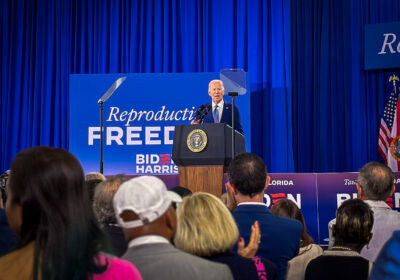Giving vinyl another spin
Parents might be surprised to learn that vinyl records popular in the ’60s and ’70s are experiencing a revival, including in students’ collections.
Indeed, figures suggest that a growing number of listeners are plugging in turntable headphones and switching over to records – with stores and students in Tampa supporting the change.
According to Nielsen SoundScan, vinyl sales only equal about 1 percent of total U.S. music revenue, but sales grew 33 percent in 2009 – and those figures don’t include all independent stores, which account for two-thirds of record purchases.
Mojo Books & Music owner Dan Drummond said that when his store started collecting vinyl, others were unsure that the format could be profitable.
“We started doing it, and people thought we were crazy,” Drummond said. “They would say, ‘Oh, I have those packed in my garage.'”
Now, wooden crates with hundreds of well-worn records surround the CDs and DVDs, while glossy new Against Me! and Radiohead records are displayed on a shelf in the store’s center. He said that vinyl records are the store’s third-best selling item with sales on the rise.
He also said that records are a frequent purchase for students near Mojo’s Fowler Avenue location, so he has to choose carefully when ordering new releases or reissues.
“There’s so much now that we can’t afford getting it all,” Drummond said.
Other Tampa music stores – Vinyl Fever on 4110 Henderson Blvd. or Sound Exchange on 14246 Nebraska Ave. – offer shelves of records to root through.
All three stores buy used records in good condition, and Vinyl Fever will accept gift certificates from corporate chains that sell music in exchange for store credit.
On April 17, these three stores and St. Petersburg music shops^w^n ^> were packed with customers during Record Store Day, with limited-edition albums and singles.
USF music professor Paul Reller said that he mostly listens to digital music because of its accessibility and doesn’t buy new vinyl, but thinks records do have advantages – both for listening to musical performances and for musical performers themselves.
“It’s great for scratching, of course,” Reller said. “Although you can scratch now with CDs and other devices, it just looks like scratching, and DJs like to do it.”
Last weekend, Sarasota hosted the Vinyl Music Festival – a four-day electronic music festival including artists like Scooter & Lavelle – and the idea that “the roots of electronic music started with vinyl,” according to the event’s website.
Reller said that beyond vintage appeal or album sleeves, a record kept in optimal condition can offer enviable sound quality.
“A record that’s in good shape that’s played on a really good stereo probably has better high-end resolution in the frequencies than a CD,” Reller said.
Some audiophiles prefer vinyl’s imperfections. Records can produce “fuzz,” hisses or noise from the player’s needle steadily running against the record’s grooves.
“It does have a certain warmth to it,” Drummond said of the format.
However, Reller said that old, fragile LPs and EPs are susceptible to sound damage from dust and groove cracks – and any student buying cheap thrift store records should consider one particular danger in sunny Tampa.
“They will warp in the sun,” Reller said. “I’ve had records warp on me before.”
Many 21st century records are made of 180 gram vinyl, which is a thicker, sturdier material that can help reduce the warping older 120 or 140 gram releases may suffer from.
The gap between vinyl and other music mediums is shrinking as well. Music labels now include digital download codes with new vinyl records, so listeners can still put songs on their iPods and portable players.
Sony and Ion sell USB turntables that allow owners to convert song tracks into audio mp3s, which, in turn, can be burned onto CDs.
Electronic musician Jeff Mills even made headlines with his release “The Occurrence” – which plays as a normal CD on one side, and plays like a 5-inch record when flipped over.
Michael Crown, a sophomore majoring in anthropology, said he became interested in vinyl as a young child by sifting through his father’s collection and looking at album artwork.
“I like how it’s a medium that forces you to sit down and listen to an entire record as a whole,” Crown said.
He said he also enjoys the crackles and surface noise of vinyl records.
“The fuzz is one of those special parts you don’t normally get, and it’s different for every record,” Crown said.
Crown acquires records through purchases at Mojo, on eBay and trades with friends as vinyl becomes more popular.
He said that vinyl’s resurgence in popularity might be explained by a search for an “authentic” experience in an age of Zunes and iTunes.
“Through all the Internet and downloading now, music is kind of depersonalized in a way, and vinyl is a way to return to a more natural experience,” Crown said.






